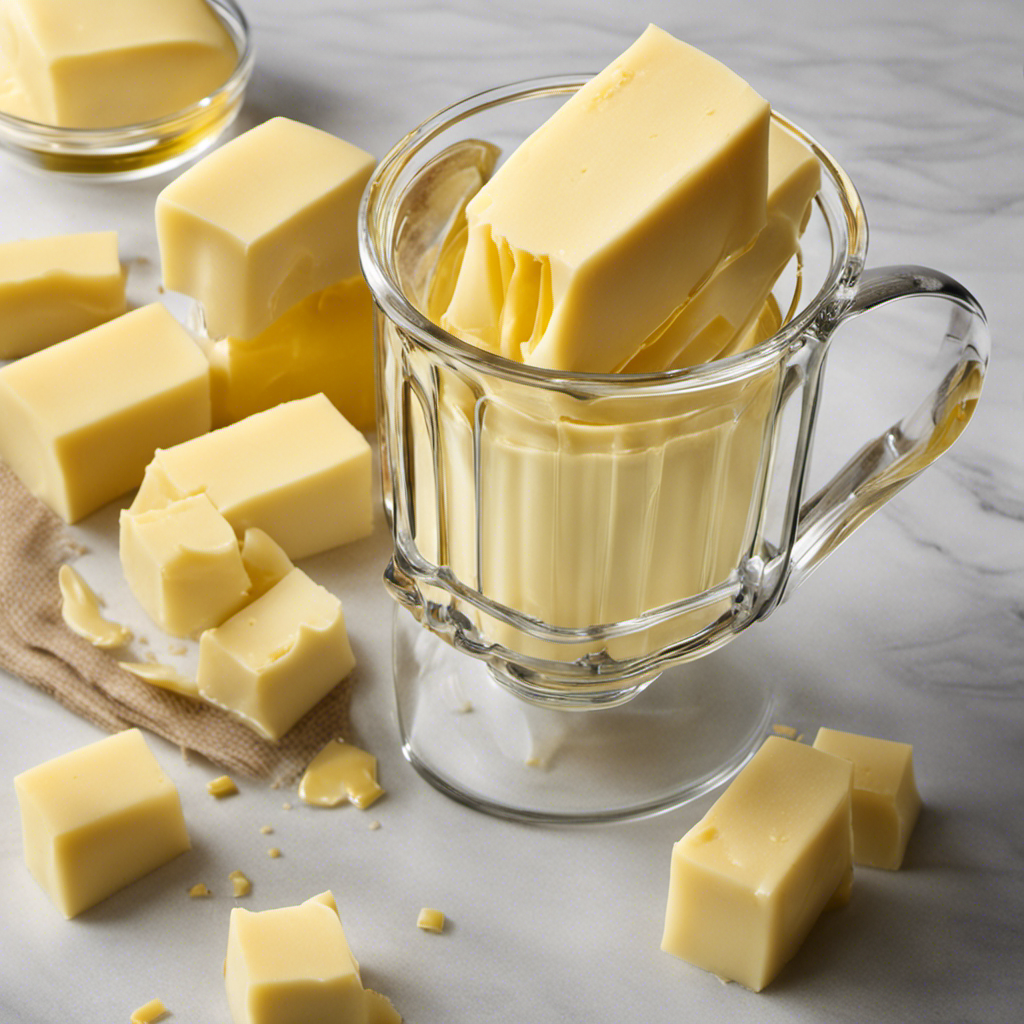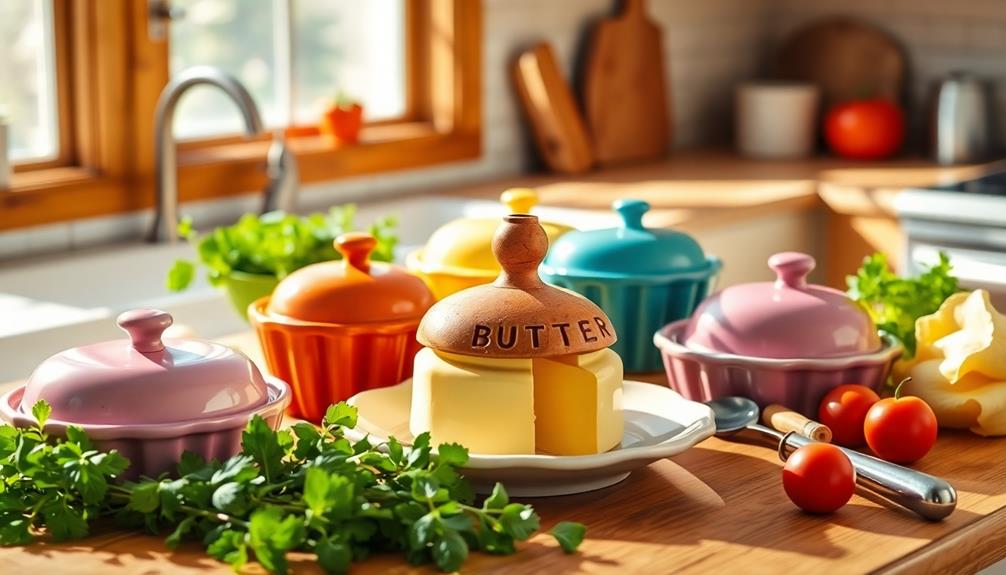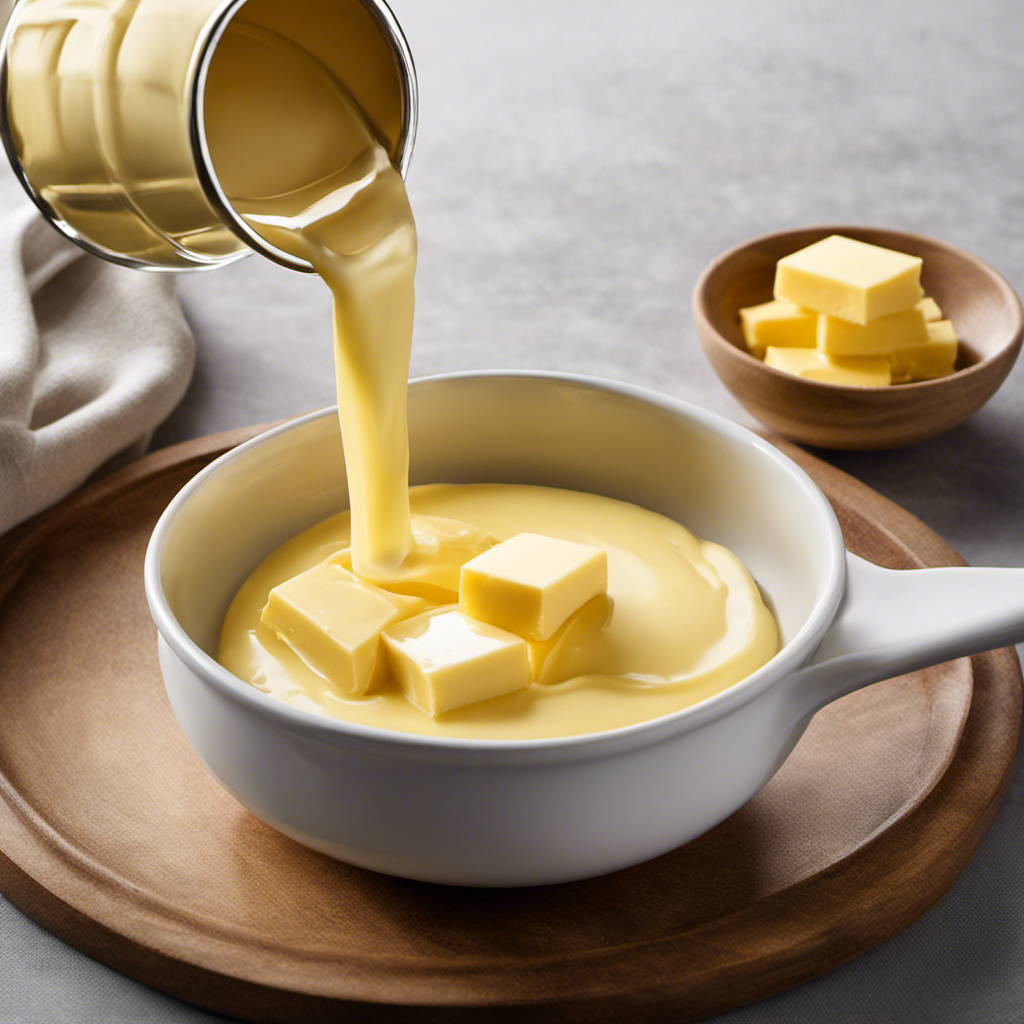Are you aware that three-quarters of a cup of butter equals how many butter sticks? Guess what, I have the solution for you!
In this article, we will delve into the world of butter measurements and uncover the secrets of converting cups to sticks of butter.
From understanding the butter to cup ratio to handy tips for using butter in recipes, we’ve got you covered.
So let’s get started and demystify this buttery dilemma once and for all.
Key Takeaways
- 3/4 of a cup of butter is equivalent to 1.5 sticks of butter
- Converting butter measurements can be confusing
- Knowing the butter equivalents is crucial for following recipes accurately
- Properly storing butter helps maintain its freshness and flavor
Understanding Butter Measurements
To understand butter measurements, it’s important to know how many sticks of butter are in 3/4 of a cup. Converting butter measurements can be confusing, but once you know the butter equivalents, it becomes much simpler.
In the case of 3/4 of a cup, it is equivalent to 1 and a half sticks of butter. Each stick of butter is typically 1/2 cup, so when you have 3/4 of a cup, you will need to use one and a half sticks. This knowledge is crucial when following recipes that call for specific measurements of butter.
Now that we understand how many sticks of butter are in 3/4 of a cup, let’s move on to converting cups to sticks of butter.
Converting Cups to Sticks of Butter
You can convert 3/4 of a cup into sticks of butter by dividing it by 0.5. This means that 3/4 cup is equivalent to 1.5 sticks of butter. Understanding different butter types is essential when it comes to cooking and baking. Butter is available in various forms, such as salted, unsalted, and clarified butter. Each type has its own unique characteristics and uses. Properly storing butter is also crucial to maintain its freshness and flavor. It is recommended to keep butter in an airtight container or in its original packaging in the refrigerator. This helps to prevent it from absorbing odors and flavors from other foods. Additionally, freezing butter is a great way to extend its shelf life. By following these tips, you can ensure that your butter stays fresh and ready for your culinary creations.
| Butter Type | Characteristics |
|---|---|
| Salted Butter | Contains added salt for flavor |
| Unsalted Butter | Does not contain added salt |
| Clarified Butter | Butter with milk solids removed for higher smoke point |
| European Butter | Higher fat content, creamier texture |
The Butter to Cup Ratio
The ratio of butter to cups can vary depending on the recipe and desired consistency. When it comes to baking, the amount of butter needed can greatly affect the texture and taste of the final product. Here are a few things to consider when measuring butter for your recipes:
-
The melting point of butter: Different types of butter have different melting points. For example, unsalted butter has a lower melting point compared to salted butter. This can affect the outcome of your baked goods, so it’s important to use the right type of butter specified in the recipe.
-
The type of butter: There are various types of butter available, such as European butter, clarified butter, and vegan butter alternatives. Each type has its unique qualities and can yield different results in your baking.
-
The consistency of butter: Softened butter, melted butter, and cold butter all have distinct roles in baking. Depending on the recipe, you may need to adjust the amount of butter or the method of incorporating it to achieve the desired consistency and texture.
Understanding the butter to cup ratio and considering these factors will help you achieve delicious and consistent results in your baking endeavors.
Calculating 3/4 of a Cup in Sticks of Butter
Calculating 3/4 of a cup in sticks of butter can be done by dividing the cup measurement by 8.
Understanding butter equivalents is essential when it comes to measuring butter for cooking. Butter is often sold in sticks, and each stick typically measures 1/2 cup or 8 tablespoons.
So, if you have a recipe that calls for 3/4 of a cup of butter, you can easily determine that it is equal to 1 and 1/2 sticks of butter. This conversion is crucial for accurate measurements in baking and cooking. It allows you to follow recipes precisely and ensures that the right amount of butter is used.
How to Measure Butter for Baking
To measure butter for baking, all you need to do is divide the cup measurement by 8. This simple trick ensures that you are measuring butter accurately and using the right amount in your recipe.
Here are some helpful tips to make your butter measuring experience a breeze:
- Use a sharp knife to cut off the desired amount of butter from the stick.
- If your recipe calls for tablespoons or teaspoons of butter, use a measuring spoon to scoop out the necessary quantity.
- Softened butter can be easily measured using a measuring cup. Just press the butter into the cup until it reaches the desired level.
Handy Butter Conversion Chart
Now that we know how to measure butter for baking, let’s take a look at a handy butter conversion chart. Understanding butter measurements is essential when following a recipe accurately. To make things easier for you, I’ve created a simple table below:
| Cups of Butter | Sticks of Butter |
|---|---|
| 1/4 | 1/2 |
| 1/2 | 1 |
| 3/4 | 1 1/2 |
In this table, you can see the conversion between cups of butter and sticks of butter. For example, if a recipe calls for 3/4 cup of butter, you can simply use 1 1/2 sticks of butter. This chart will help you save time and avoid any confusion when it comes to measuring butter for your baking adventures. So go ahead, whip up some delicious treats with confidence!
Tips for Using Butter in Recipes
When using butter in recipes, remember to soften it before adding it to your mixture. Softening butter allows it to blend more easily with other ingredients, resulting in a smoother and more evenly textured dish.
Here are some tips for storing butter and creative ways to use it in recipes:
-
Storing Butter:
-
Keep butter in its original packaging or transfer it to an airtight container to prevent it from absorbing odors in the refrigerator.
-
For longer storage, freeze butter in individual portions, tightly wrapped in plastic wrap or placed in a freezer bag.
-
To prevent butter from spoiling, always check the expiration date and discard any butter that has an off smell or taste.
-
Creative Uses for Butter in Recipes:
-
Use melted butter as a flavorful alternative to oil when sautéing vegetables or frying eggs.
-
Incorporate softened butter into baked goods like cookies, cakes, and scones for a rich and tender texture.
-
Spread softened butter on toast or bread and top with cinnamon sugar for a quick and delicious treat.
Other Common Butter Measurements
When it comes to baking, butter plays a crucial role in achieving the perfect texture and flavor. However, sometimes recipes call for specific measurements of butter that can be confusing.
In this discussion, I will cover butter conversions for baking, including how many sticks of butter are in a cup, as well as provide information on butter substitutes and ratios.
Additionally, I will explore the different packaging sizes of butter available, giving you a better understanding of how to choose the right amount for your recipes.
Butter Conversions for Baking
To convert 3/4 of a cup of butter for baking, you’ll need approximately 1.5 sticks. When it comes to butter measurement equivalents and conversion tips, it’s important to have handy reference points to ensure your recipes turn out just right.
Here are a few helpful tips I’ve learned along the way:
-
Softened butter is easier to measure accurately, so take it out of the fridge in advance and let it sit at room temperature until it’s soft to the touch.
-
If you don’t have sticks of butter on hand, you can also measure butter using tablespoons. One stick of butter is equal to 8 tablespoons.
-
For smaller measurements, such as teaspoons or tablespoons, you can use a kitchen scale to weigh the butter instead of relying on volume measurements.
By keeping these butter conversion tips in mind, you’ll be able to confidently tackle any recipe that calls for butter, knowing that your measurements are spot-on.
Happy baking!
Butter Substitutes and Ratios
If you’re looking for a butter substitute in your baking, try using mashed bananas or applesauce instead. These are great butter alternatives that not only add moisture to your baked goods, but also provide a subtle sweetness.
When using mashed bananas as a butter substitute, use a 1:1 ratio. So if your recipe calls for 1 cup of butter, simply use 1 cup of mashed bananas. Similarly, you can replace butter with applesauce using a 1:1 ratio as well.
The mashed bananas and applesauce will help bind the ingredients together, resulting in moist and delicious treats. For those who follow a vegan lifestyle, there are also vegan butter options available in stores, made from plant-based oils such as coconut or olive oil. These vegan butter alternatives can be used in the same quantity as regular butter in your recipes.
Now that you know about butter substitutes, let’s move on to exploring different butter packaging sizes.
Different Butter Packaging Sizes
Next time you’re at the grocery store, check out the various sizes of butter packaging available. It can be overwhelming to find the right butter measurement for a recipe, but having the right packaging options can make it easier.
Here are a few things to consider:
- Look for the standard stick of butter, which is usually 1/2 cup or 8 tablespoons.
- Some brands also offer larger blocks of butter, which can be measured in cups or ounces.
- If you need smaller amounts, individual butter packets or tubs are great options.
Having these different butter packaging sizes allows you to choose the right amount of butter needed for your recipe. So next time you’re wondering how much butter to use, take a look at the packaging options available and find the perfect measurement.
Now, let’s talk about butter substitutions for different measurements.
Butter Substitutions for Different Measurements
When it comes to finding suitable butter substitutes, there are a few options that can produce equally delicious results in your recipes.
First, margarine can be used as a direct substitute for butter in most recipes, providing a similar taste and texture.
For baking, coconut oil is a fantastic alternative to butter, adding a subtle tropical flavor to your treats.
Lastly, for cooking, olive oil is a versatile option that not only provides a healthy alternative to butter but also adds a rich and distinctive taste to your dishes.
Margarine as Butter Substitute
Margarine can be used as a substitute for butter in recipes. Many people have debated the butter vs. margarine topic for years, but I have found that margarine can be a healthier alternative.
Here are some reasons why I choose to use margarine in my cooking:
-
Lower in saturated fat: Margarine is made from vegetable oils, which are naturally low in saturated fat. This can be beneficial for those who are watching their cholesterol levels or trying to maintain a healthy heart.
-
Rich in essential fatty acids: Margarine is often fortified with omega-3 and omega-6 fatty acids, which are important for brain function and overall health. These fatty acids are not as prevalent in butter.
-
No cholesterol: Unlike butter, margarine is cholesterol-free, making it a better option for those with high cholesterol levels or a family history of heart disease.
Overall, using margarine as a substitute for butter can provide health benefits without sacrificing flavor in your recipes.
Coconut Oil for Baking
To enhance the taste and texture of your baked goods, you can try using coconut oil instead of butter. Coconut oil is a great alternative to traditional butter and offers a unique flavor profile that can elevate your baked treats to a whole new level.
Not only does coconut oil add a delicious tropical taste, but it also provides numerous benefits for baking. The high saturated fat content in coconut oil helps to create a moist and tender texture in your baked goods. Additionally, coconut oil is known for its ability to withstand high temperatures, making it a suitable choice for baking. Its natural sweetness can also reduce the need for added sugars in your recipes.
Overall, using coconut oil in your baking can result in healthier and more flavorful treats.
Now let’s explore another versatile oil for cooking: olive oil.
Olive Oil for Cooking
Using olive oil in your cooking can add a rich and distinct flavor to your dishes. It’s one of the best cooking oils out there, not only for its taste but also for its numerous benefits.
Here are a few reasons why I love using olive oil in my kitchen:
-
Health benefits: Olive oil is known for its heart-healthy properties and is rich in monounsaturated fats, which can help lower bad cholesterol levels and reduce the risk of heart disease.
-
Versatility: Olive oil can be used in a variety of cooking methods, whether you’re sautéing vegetables, grilling meats, or even drizzling it over a salad.
-
Enhanced flavors: Olive oil has a unique flavor profile that can enhance the taste of your dishes, from a simple pasta sauce to a homemade salad dressing.
Frequently Asked Questions
How Do I Convert Tablespoons of Butter to Sticks of Butter?
When converting butter measurements, it’s helpful to know that 1 stick of butter is equal to 8 tablespoons. To convert tablespoons to sticks, simply divide the number of tablespoons by 8.
Can I Use Margarine as a Substitute for Butter in Baking Recipes?
In baking, it’s important to know the substitutes for butter. Margarine can be used, but it has different properties. It contains more water, so it may affect the texture and taste of your baked goods.
What Is the Difference Between Salted and Unsalted Butter in Recipes?
Salted vs unsalted butter: Which is better for baking? The type of butter used affects the texture of baked goods. Salted butter has added salt, while unsalted has none. It’s best to use unsalted for more control over the saltiness in recipes.
How Do I Measure Melted Butter for Baking?
When measuring melted butter for baking, it’s important to know the conversions for butter measurements. To determine how many sticks of butter is 3/4 of a cup, you can use a butter measurement chart or guide.
Is There a Difference in Measurement Between European-Style Butter and Regular Butter in Recipes?
I’ve always wondered if there’s a difference in measurement between European-style butter and regular butter in recipes. Does the type of butter affect the texture of baked goods? Let’s find out!
Conclusion
In conclusion, understanding butter measurements is crucial for successful baking. Converting cups to sticks of butter can be easily done by using the butter to cup ratio. Calculating 3/4 of a cup in sticks of butter is simple once you know the conversion.
Remember to use a handy butter conversion chart to make your baking experience easier. While some may argue that using butter substitutes is more convenient, it’s important to note that butter provides a rich and flavorful taste that cannot be replicated.
So next time you’re in the kitchen, embrace the butter and create delicious treats!










